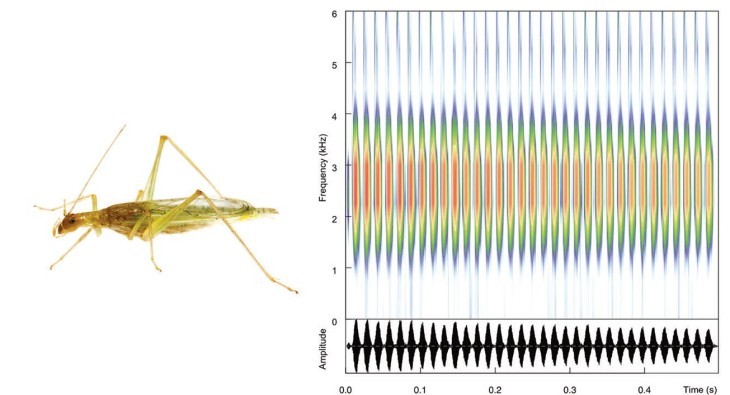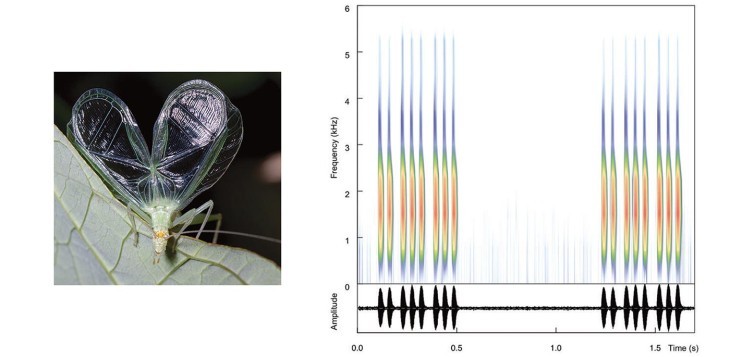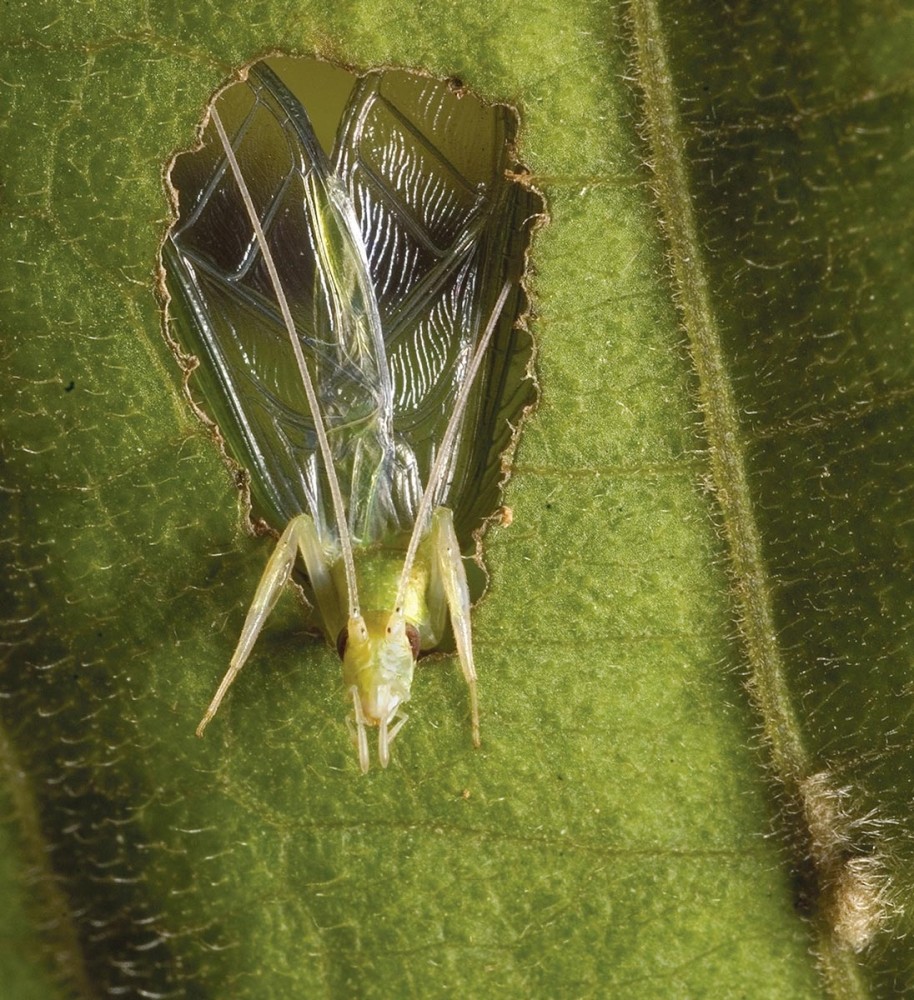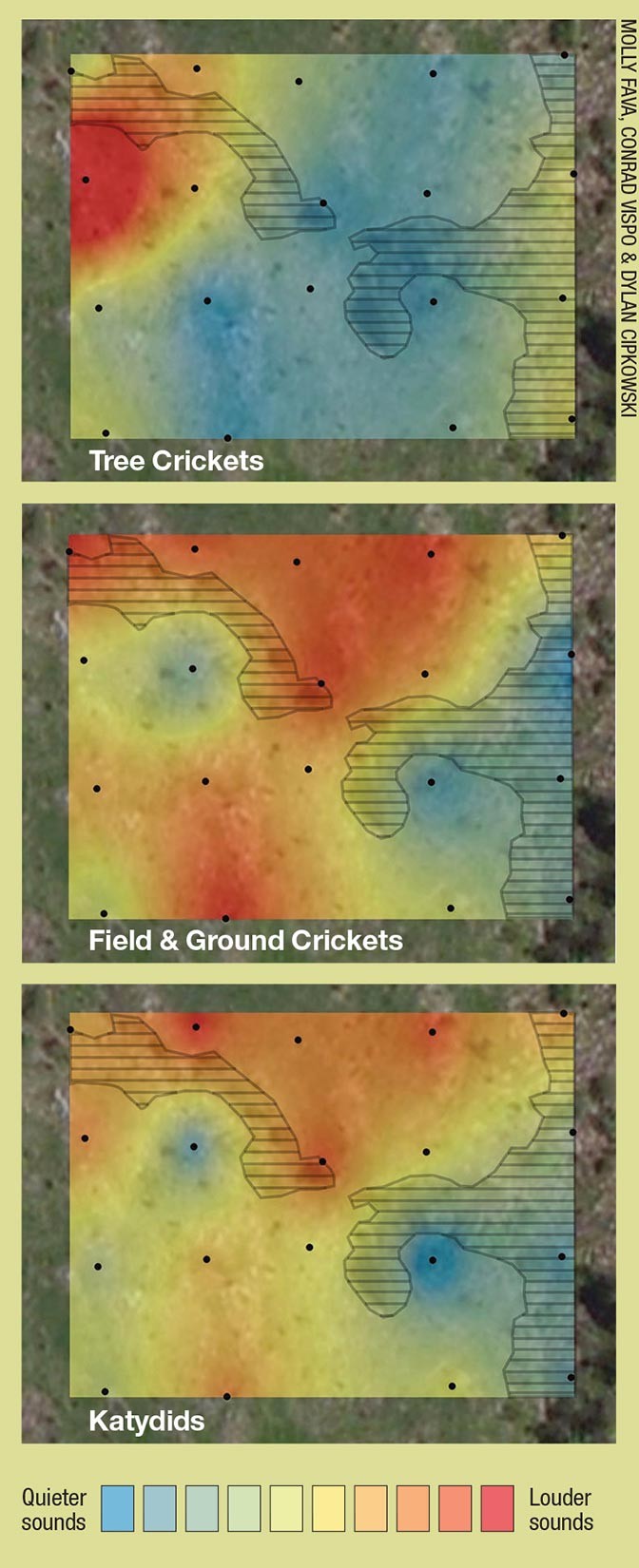The cricket sang,
And set the sun,
And workmen finished, one by one,
Their seam the day upon.
Emily Dickinson
No matter where one lives in the Northeast, the song of the cricket serves as both a call to rest and a harbinger of autumn. In our northern woodlands, the tree crickets join their meadow brethren – field crickets and katydids – in the evening to compete in a chorus of mating songs throughout the lengthening nights. Here, in a new department focused on the use of technology for forest and wildlife monitoring, we explore forest bioacoustics – research on the sounds of nature found within our woodlands – by examining fall’s cricket symphony.
Male tree crickets make their sound by rubbing one wing against a serrated vein of the other wing – a mechanism called stridulation. The vibration of their wings causes changes in the air pressure around them – compressing the air as the membrane in the wing vibrates – similar to the way the membrane of a loudspeaker works. This vibration of air creates the sound that we hear. The louder the call, the better the chance of attracting a mate. Each species calls at a different pitch and pulse to attract females of their same species. Some field crickets also have courtship songs to convince a female she has found the perfect mate.

Researcher Laurel Symes, the assistant director of the Center for Conservation Bioacoustics at the Cornell Lab in Ithaca, New York, has an affinity for studying creatures that make noise in the night. She has been studying the sound of crickets and katydids, among other organisms, since 2007. Some of Symes’ research focuses on how animals choose mates, and how this affects the boundaries between species. Other research has looked at the impact of human-created noise, such as road traffic, on the behavior of crickets and the insects’ perception of sound during breeding season.
In both cases, the ability to “see” sound through a graph called a spectrogram provides important information on the pulse rate of individual species of cricket and how their sound changes over time, locale, and changing weather or temperature (see graphs at right). The differences in pulse rate can be very subtle between species, so the ability to see the sound data allows for certainty in identifying species, and reveals where and when they call in relation to other species of interest. Spectrograms also provide interesting and sometimes unexpected insights. For example, female tree crickets seem to prefer bass notes – a lower frequency apparently indicates a larger male (and presumably more sperm).

Researching and monitoring cricket behavior, abundance, and diversity provides a window into the health of the landscape being studied. As food for birds, mammals, insects, bats, and even each other, crickets comprise a critical piece of the woodlands and meadow food web. Although their songs are a sign of shorter days and longer nights to come, it is also a comfort and a promise that the next generation of songmakers will be with us the following year.
Tree crickets with smaller wings run into a problem where the movement of the air meets the edge of their wings and cancels out the sound – in essence, short-circuiting their ability to attract a mate. These crickets compensate by chewing a hole in the center of a leaf and calling from the center of the hole with their wings pressed flat, creating a baffle that can accentuate the sound (see this link).
After mating, female tree crickets drill holes into sturdy plant stems or tree branches to deposit their eggs. Each species has its own preference for ovipositing the eggs; for example, some species lay their eggs in single holes spaced out neatly in a row, while others lay two eggs side by side in each hole. They seal the holes with frass (insect poop) or chewed bark.
The eggs develop during the winter and hatch in the spring, when nymphs emerge. The nymphs go through five or more instar stages of growth and shedding of skin before reaching adulthood by late summer, when this next generation of crickets begins the chorus anew.
Mapping Sound
The Hawthorne Valley Farmscape Ecology Program studies the interaction of wild nature and agriculture in the Hudson Valley, NY. They are exploring whether sound mapping can provide a shortcut for understanding a farm’s potential to support agronomically-beneficial organisms and native species of conservation interest. To see and hear a 24-hour animation of these maps, click here.
These maps show the calling patterns of three types of singing insects at noon in a shrubby pasture. The areas of the map covered by gray horizontal lines represent the tree- and shrub-covered land, while the uncovered areas of the map represent the open grassland. At this time of day, the loudest calling from the tree crickets seemed to be coming from the tree and shrub covered areas, while the loudest calling from the field and ground crickets seemed to be coming from the open grasslands. As shown in the legend above, warmer colors represent higher relative sound pressure and cooler colors represent lower relative sound pressure.
Web Extras: Related Content
You can learn more about Cornell's Center for Conservation Bioacoustics and Laurel Symes's work here.
Explore more sounds from nature at the Macauley Sound Lab.
Learn more about crickets in this Outside Story: Chirp, Click, Buzz – Last Call for the Insect Orchestra



